Janki Mahal Is An Ideal Place To Embark For An Incredible Religious Experience In 2025
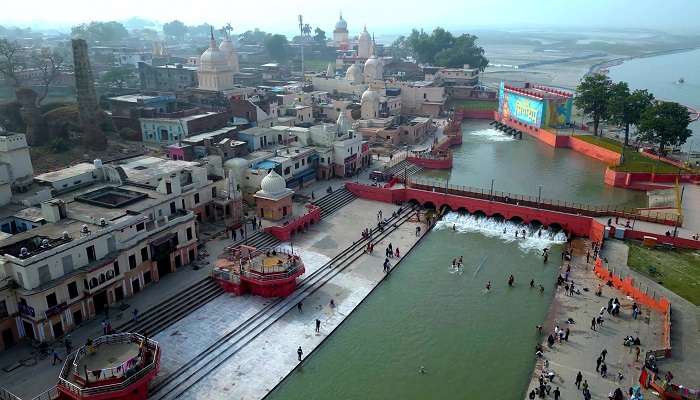
Janki Mahal in Ayodhya is both a Hindu temple that is dedicated to Lord Ram and Goddess Sita as well as a place to stay or a dharamshala. It is a beautiful establishment with a colourful facade and is quite spacious, attracting large crowds of devotees and tourists daily. Located very close to the Ram Mandir, this spacious property has two and three bedded rooms and a bhojanalaya. If you are visiting Ayodhya with family and are looking for affordable accommodations, Janki Mahal is the perfect choice since it offers comfortable lodging with a religious experience.
About Ayodhya’s Janki Mahal
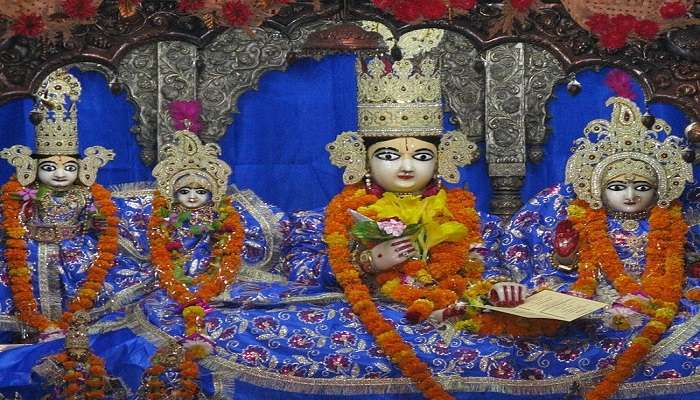
It is quite common to stay in hotels, guesthouses or hostels when travelling so if you are looking for a unique experience when travelling to Ayodhya, you should consider staying at the Janki Mahal. The building’s exterior features colourful walls and decorated pillars, while the inside is quite sizeable and has rooms with 2 and 3 beds. Sri Janki Mahal, about 700 metres from the Ayodhya bus stop, is close to the Ram Mandir and only open to families. There is a bhojanalaya on the premises where they serve vegetarian meals made without onion and garlic. You can choose between an air-conditioned or non-air conditioned room, and there is also hot water for your use.
Moreover, the temple on the premises has idols of Lord Rama and Goddess Sita. You can attend pujas and aartis here and you would hear chanting throughout the day. It is often said that the two deities stayed around this area following their nuptials. Janki Mahal offers a tranquil and religious experience, one that you would not find in most places!
Must Read: Ayodhya Ram Mandir
Best Time To Visit Ayodhya And How To Reach
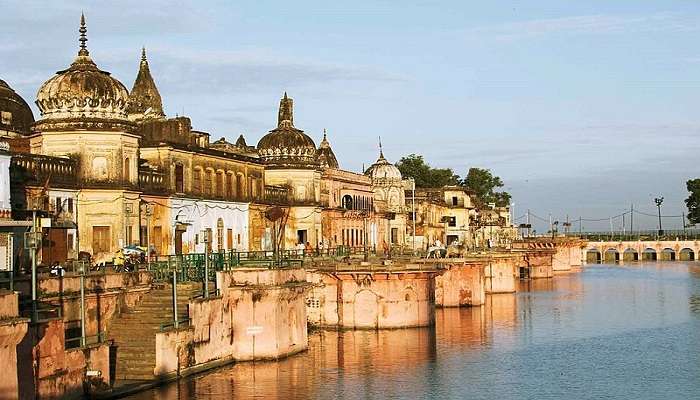
Save a few months in the summers when the temperatures rise a bit or in the winters when it gets a little cold; Ayodhya is a great place to visit throughout the year. However, the best time to visit is from October to March, specifically between the months of October and December. The cool and pleasant weather is perfect for being outdoors. Furthermore, if you visit in the wintertime, you will also get a chance to celebrate major festivals like Diwali and Dussehra, which are celebrated with great gusto here. The summer months from April to June usually bring about hot weather, making sightseeing, visiting temples and attending aartis slightly unpleasant. On the other hand, while the monsoon season from July to September brings about rainfall, which provides a little relief from the heat, the city is prone to heavy showers, which could derail your plans to be out and about.
Getting to Ayodhya is fairly simple if you live in nearby cities in Uttar Pradesh since you can drive here or hire a cab. Both make it easy to explore the city and its neighbouring areas. Moreover, you can also take the bus since Ayodhya has its own bus stand; frequent buses come here from nearby cities. You can think of flying here since there are two airports where you can land. The first and closest one is in Faizabad, which is about 9 km away. However, the airport doesn’t receive as many flights regularly. The more suitable option would be to fly to the airport in Lucknow, which is about 161 km away since it is a major airport. You can also take a train since the city is home to the Ayodhya Junction Railway Station. It is not too far from the city centre, and trains come in from nearby cities.
Significance Of Ayodhya
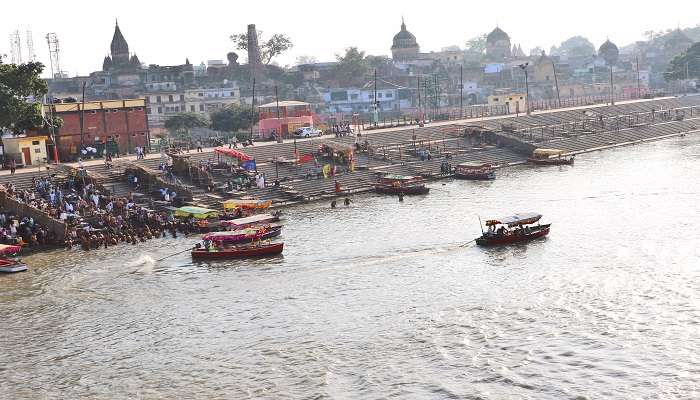
Ayodhya in Uttar Pradesh is one of the most revered cities in India and was once known as Saketa. It is located alongside the Sarayu River and is the administrative capital of the state’s Ayodhya District and Division. However, it is important to both Hindus and Buddhists.
The city’s name somewhat translates to “invincible” or even “the unconquerable city of Gods.” As per the epic Ramayana, Ayodhya is Ram Janmabhoomi, the place where Lord Rama was born. It was the capital of the Kosala kingdom. For this reason, the city is one of India’s seven most prominent pilgrimage sites. On the other hand, Buddhist and Jain scriptures state that their respective religious leaders, Gautama Buddha and Mahavir, had spent considerable time in Ayodhya. Moreover, according to Jainism, the Tirthankaras were born in this area as well.
Suggested Read: Hotels In Ayodhya
Ayodhya’s Must-visit Attractions
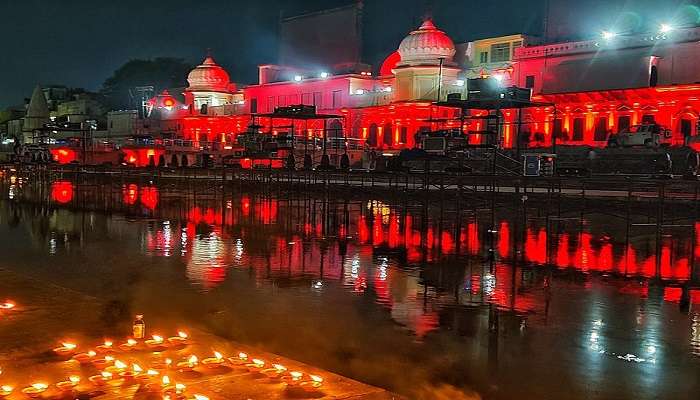
Ayodhya is one of India’s most religious destinations, and there are several things for you to do and see in this sacred city, some of which are as follows:
- You must visit the Ram Mandir. The temple is built on the site where Lord Rama was supposedly born. Its magnificent structure can easily accommodate the lakhs of devotees who visit daily. On its inauguration day, over half a million visitors visited the temple. You must attend aartis at the temple.
- Besides the Ram Mandir, there are many other temples in this holy city where you can offer prayers. Kanak Bhawan, also known as Sone ke Ghar, is another temple dedicated to Lord Rama and Goddess Sita and was built in the late 19th century. Some of the other temples are Hanuman Garhi, built in the 10th century, and Nageshwar Temple, believed to have been built by Lord Rama’s son Kush and Treta ke Thakur. This temple along Naya Ghat contains idols of Lord Hanuman, Rama, Lakshman, Bharat and Sugreev, and Goddess Sita, all made out of black sandstone.
- Don’t forget to visit Gulab Bari, which houses the tomb of Faizabad’s third Nawab. It is also known as the Garden of Roses since it features many roses, beautiful green gardens, and fountains. The establishment has been declared a site of national heritage.
- It would be a wonderful experience to visit Sita ki Rasoi, located quite close to the Ram Mandir. It is believed to have been used by Goddess Sita herself; there is a temple on the site with a few exhibit vessels.
- If you plan on visiting later in the year, it would be a great idea to coincide with Ayodhya Deepotsav, a major festival celebrated here to commemorate Lord Rama’s victory over Ravana and his return following his exile. It is celebrated by lighting thousands of diyas along the banks of the Saryu river.
Further Read: Hill Stations Near Uttar Pradesh
Ayodhya is a deeply special city in India, primarily for its religious and spiritual significance so if you are planning to visit, staying at the famous Janki Mahal would be a splendid idea since it is not like other kinds of lodging. Moreover, there are many cities around Ayodhya that would make for great excursions so you can also think of planning a trip to Uttar Pradesh to uncover its many attractions. So start planning your holiday now!
For our editorial codes of conduct and copyright disclaimer, please click here.
Cover Image Source: Shutterstock
Frequently Asked Questions About Janki Mahal
Does Janki Mahal accept unmarried guests?
No it does not so if you are travelling alone, you might need to find another accommodation.
What are the different aartis at the Ram Mandir?
There are three aartis at this temple. The first one is the Mangala Aarti which begins at 4:00 AM. The Shringar Aarti is at 6:15 AM and Shayan Aarti is at 10:00 PM. You might need a pass to attend aartis here.
What are some rules when visiting the Ram Mandir?
Since it is a place of worship, you must make sure to dress modestly and to not carry your footwear, mobile phone, handbags etc. inside. It is also prohibited to bring in flowers or garlands.
Where can one attend religious performances in Ayodhya?
The best place to watch religious performances like music shows, dances, plays, poetry recitals and more in Ayodhya is at the Ram Katha Park.
Which city is closest to Ayodhya?
Faizabad, about 7 km away, is the city closest to Ayodhya and it is also known as ‘Old Ayodhya.
People Also Read:
Ta Nei Temple Gauri Shankar Temple Mridanga Saileswari Temple

Innovative Content Writer Focused on Producing High quality, Original Content that drives traffic and engages readers. Experienced in Content strategy and analytics to measure content performance using tools such as SQL, Power BI, Excel.











